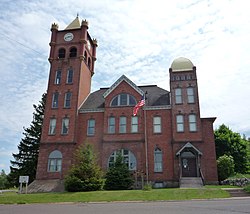Iron County | |
|---|---|
 The Old Iron County Courthouse (now the Iron County Historical Museum) in Hurley, Wisconsin. | |
 Location within the U.S. state of Wisconsin | |
 Wisconsin's location within the U.S. | |
| Coordinates: 46°20′N90°16′W / 46.33°N 90.26°W | |
| Country | |
| State | |
| Founded | 1893 |
| Named after | Iron ore |
| Seat | Hurley |
| Largest city | Hurley |
| Area | |
• Total | 919 sq mi (2,380 km2) |
| • Land | 758 sq mi (1,960 km2) |
| • Water | 161 sq mi (420 km2) 18% |
| Population | |
• Total | 6,137 |
• Estimate (2024) | 6,235 |
| • Density | 8.1/sq mi (3.1/km2) |
| Time zone | UTC−6 (Central) |
| • Summer (DST) | UTC−5 (CDT) |
| Congressional district | 7th |
| Website | www |
Iron County is a county located in the U.S. state of Wisconsin. As of the 2020 census, the population was 6,137, [1] making it the third-least populous county in Wisconsin. Its county seat is Hurley. [2] It was named for the valuable iron ore found within its borders. [3] [4] The county overlaps with small parts of the Bad River and Lac du Flambeau Indian reservations. The county is considered a high-recreation retirement destination by the U.S. Department of Agriculture. [5]


